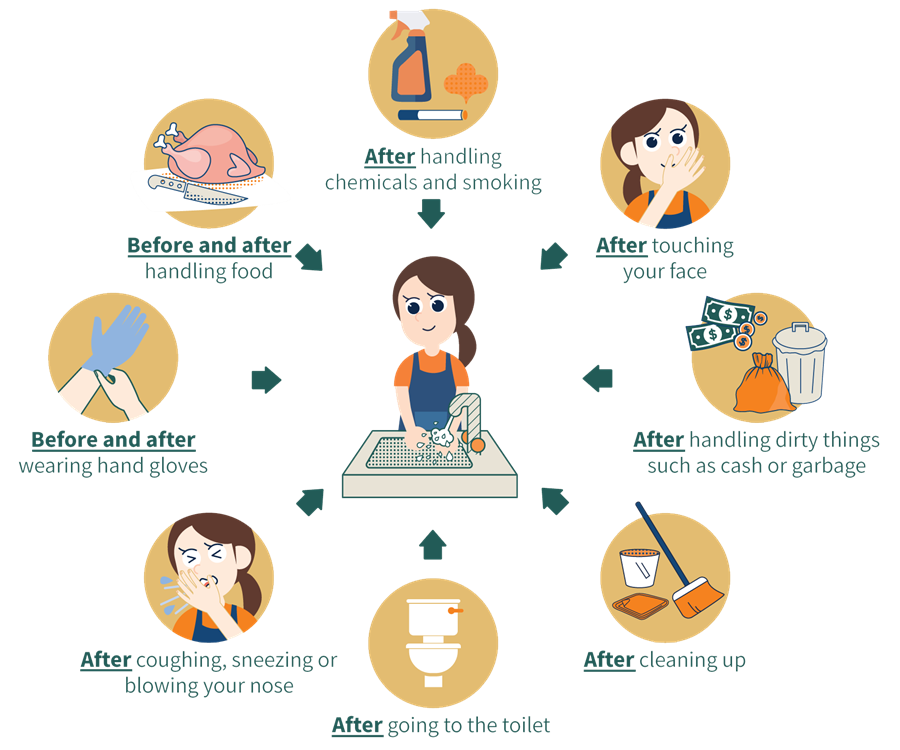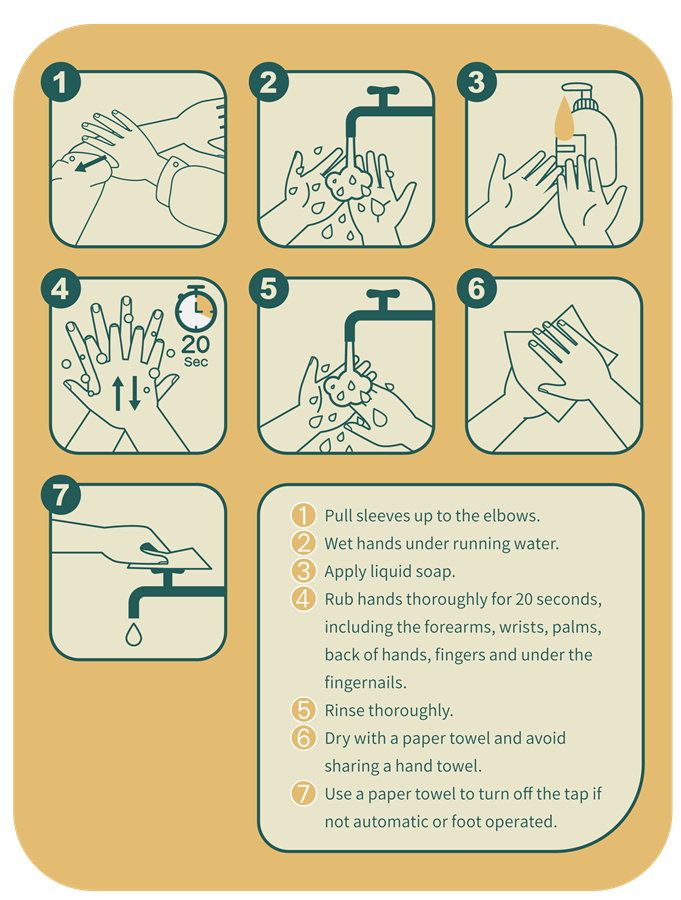Our hands may carry millions of microorganisms, some of them can make us sick. Although bacteria are invisible, they are everywhere. It is easy for us to pick up bacteria from door handles, escalator handrails, or even our own mobile phone, face and wounds, etc. Properly cleaning your hands greatly helps prevent the spread of infectious diseases.
You should wash your hands when:
- Before and after handling food
- After going to the toilet
- After touching your face
- After coughing, sneezing or blowing your nose
- Before and after wearing hand gloves
- After cleaning up
- After handling dirty things such as cash or garbage
- After handling chemicals and smoking

To properly wash your hands:
- Pull sleeves up to the elbows.
- Wet hands under running water.
- Apply liquid soap.
- Rub hands thoroughly for 20 seconds, including the forearms, wrists, palms, back of hands, fingers and under the fingernails.
- Rinse thoroughly.
- Dry with a paper towel and avoid sharing a hand towel.
- Use a paper towel to turn off the tap if not automatic or foot operated.

Click here for the poster on steps for hand washing.
Hand washing facilities
Every food room, kitchen and scullery area should be equipped with at least one wash hand basin for use by the staff, equipped with:
- Liquid soup dispenser and liquid soap
- Disposable tissue paper
- Sensor or non-touch tap (e.g. pedal or elbow operated tap)
- Continuous supply of hot and cold water
- Pedal operated trash bin with lid
- Poster on steps for hand washing

Alcohol hand sanitisers
Food handlers should wash hands with liquid soap and water frequently as alcohol hand sanitisers work less effectively at removing grease, dirt and foodborne microorganisms. For non-food handlers, alcohol-based hand sanitisers can be used for cleaning hands when they are not visibly dirty. Otherwise wash hands with liquid soap and water.
Rub hands with alcohol hand sanitiser until they are completely dry before touching any food contact surfaces such as cutleries. Alcohol hand sanitisers should be stored away from high temperatures or flames.
Use of disposable gloves
Disposable gloves are a tool to help handle food safely, especially when there are wounds or cuts on hands, or when handling ready-to-eat food, such as salads.

 |
Wearing disposable gloves cannot replace hand washing. The following should be noted when using them:
|
Change gloves at the appropriate time:
- Between handling raw and cooked foods
- After completing each task, such as handling garbage
- When gloves are torn or dirty
- When gloves are wet with hand sweat
- When switching jobs or shifts
- Using tools such as food tongs can also avoid bare hand contact with foods

Mobile phones
Mobile phones have become indispensable to us in our daily lives. Besides the use of personal mobile phones by food handlers, more restaurants are using mobile phones or self-service ordering machines to take customers' orders. Bacteria from the phone are likely to be transferred to hands and then to food, causing cross-contamination and a food safety risk to customers. Therefore, food handlers should be aware of the following advice:
- Never use your mobile phone while preparing food.
- Never leave your mobile phone on a workstation for food preparation.
- If you have touched your mobile phone before preparing food, wash your hands.
- Frequently disinfect your mobile device with alcohol-based wipes or sprays.
- If customers ask for taking photos at their table, wash your hands immediately after touching their mobile devices.
- Never use your mobile device while in the washroom.
 |
It is a good practice for food handlers to put their mobile phones in the staff room or locker before handling food, so that they can concentrate on their work. This also avoids contaminating their hands or gloves by touching the mobile phone, saving the trouble of washing my hands or changing gloves again. |





